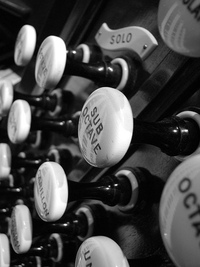
Terminology
Each pipe plays one note. Pipes of similar design sound similar, and a group of pipes that sound similar but play various pitches is called a rank of pipes.
A division is one of the keyboards (also called manuals) or pedalboard. Divisions generally have names, e.g. Great, Swell, Pedal, etc.
A stop is a knob on the organ console (where the organist sits) that stops and unstops the air from entering a rank of pipes. Stops are associated with divisions, so stops allow us to control which ranks sound when a division is played.
When a stop is pulled, the rank is active. So when a stop is "on," it is unstopped. Thus, the term "pull out all the stops" means to play the full organ (which is loud and dramatic).
Divisions can be coupled. Coupling Swell to Great will cause the stops pulled for the Swell division to sound when the Great division is played.
The organist's choice of stops is called the registration of the organ. He can produce a wide range of sounds, from soft and sweet to loud and bombastic. Thus, the Registration Detective detects which stops are pulled in an audio recording.
Stops
Informally, organists tend to refer to ranks and knobs both as stops, since that is the interface presented to the organist. In addition, a certain kind of pipe is often referred to collectively as a stop. For example, all Principal stops have pipes of similar shape, length, and material composition, regardless of the organ in which they are found. More importantly, all Principal stops sound, in some essential way, the same.
Stop names are usually followed by a length, e.g. 8'. This identifies the octave of that rank, and is usually the length of the longest pipe in the rank. 8' is the unison octave, and corresponds to octave you'd hear playing the same notes on the piano. 4' is an octave above, 2' an octave above that, 16' an octave below 8', and so forth. Some harmonic stops, like the Nasard 2⅔, are a different interval (the fifth in this case).
There are four basic stop families. The diapasons are stops that produce the distinct organ sound (Principal, Octave, Diapason). The flutes are softer, purer sounds (Flöte, etc.). The strings mimic orchestral strings (Viol, Gamba, etc.). The reed stops have vibrating reeds and produce sounds similar to orchestral reeded woodwinds and brass instruments (Krumhorn, Trompette, Bombarde, Oboe, etc.). Some stops lie in between these categories, and some are sounds unto themselves.
The names of stops have propogated through the centuries. Sometimes they are in French, sometimes in German, and sometimes in English, and often a single organ will have a combination of all languages (depending on the heritage of each individual stop). Much more information can be found in Organ-Stops and Their Artistic Registraion by G. A. Audsley and online at the Encyclopedia of Organ Stops.